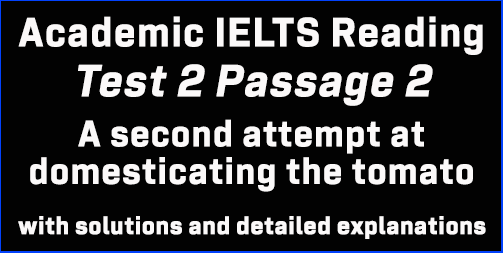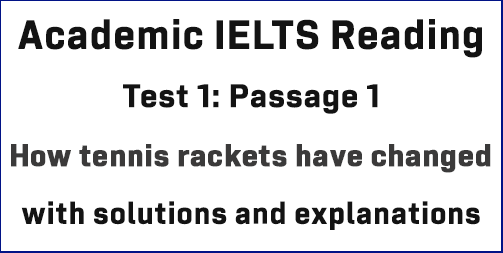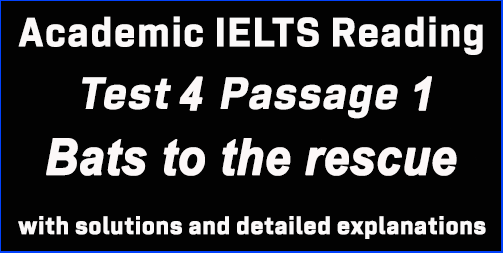Academic IELTS Reading: Test 2 Passage 2; A second attempt at domesticating the tomato; with top solutions and best explanations
This Academic IELTS Reading post focuses on solutions to IELTS Reading Test 2 Passage 2 that has a text titled ‘A second attempt at domesticating the tomato’. This is a targeted post for AC IELTS candidates who have big problems finding out and understanding Reading Answers in the AC module. This post can guide you best to understand every Reading answer without much trouble. Finding out IELTS Reading answers is a steady process, and this post will assist you in this respect.
Academic IELTS: Reading Module
Passage 2: Questions 14-26
The headline of the passage: A second attempt at domesticating the tomato
Questions 14-18: Identifying information
[This question asks you to find information from the passage and write the number of the paragraph (A, B, C or D … .. ) in the answer sheet. Now, if the question is given in the very first part of the question set, I’d request you not to answer them. It’s mainly because this question will not follow any sequence, and so it will surely kill your time. Rather, you should answer all the other questions first. And just like List of Headings, only read the first two lines or last two lines of the expected paragraph initially. If you find the answers, you need not read the middle part. If you don’t find answers yet, you can skim the middle part of the paragraph. Keywords will be a useful matter here.]
Question no. 14: a reference to a type of tomato that can resist a dangerous infection
Keywords for this question: a type of tomato, can resist, dangerous infection,
Take a look at the first few lines of the third paragraph in Section C. The writer says here, “The team in China re-domesticated several strains of wild tomatoes with desirable traits lost in domesticated tomatoes. In this way they managed to create a strain resistant to a common disease called bacterial spot race, which can devastate yields. . .. . . . . . .”
Here, a strain = a type of tomato,
resistant to a common disease called bacterial spot race = can resist a dangerous infection,
So, the answer is: C
Question no. 15: an explanation of how problems can arise from focusing only on a certain type of tomato plant
Keywords for this question: explanation, how problems can arise, focusing only on, certain type of tomato plant,
In Section B, the author says in the opening of second paragraph, “But every time a single plant with a mutation is taken from a larger population for breeding, much genetic diversity is lost. .. … . .”
Here, a single plant with a mutation = a certain type of tomato plant,
much genetic diversity is lost = problems can arise,
So, the answer is: B
Question no. 16: a number of examples of plants that are not cultivated at present but could be useful as food sources
Keywords for this question: a number of examples of plants, not cultivated at present, but, could be useful as food sources,
The second paragraph of Section E says, “The three teams already have their eye on other plants that could be ‘catapulted into the mainstream’, including foxtail, oat-grass and cowpea. By choosing wild plants that are drought or heat tolerant, says Gao, we could create crops that will thrive even as the planet warms.”
Here, foxtail, oat-grass and cowpea = a number of examples of plants,
wild plants = are not cultivated,
we could create crops that will thrive even as the planet warms = could be useful as food sources,
So, the answer is: E
Question no. 17: a comparison between the early domestication of the tomato and more recent research
Keywords for this question: comparison, early domestication of the tomato, more recent research,
In the first lines of the first paragraph in Section A, the writer says, “It took at least 3,000 years for humans to learn how to domesticate the wild tomato and cultivate it for food. . .. .. .”
Here, It took at least 3,000 years for humans to learn how to domesticate = the early domestication of the tomato,
So, the answer is: A
Question no. 18: a personal reaction to the flavour of a tomato that has been genetically edited
Keywords for this question: personal reaction, flavour of a tomato, has been genetically edited,
In the third paragraph in Section C, the writer says, “ ‘They are quite tasty,’ says Kudla. ‘A little bit strong. And very aromatic.’ .”
Here, says Kudla = Jorg Kulda’s personal reaction,
So, the answer is: C
Questions 19-23: Matching statements with the correct researchers
[In this type of question, candidates need to relate statements which are given by or links to some researchers in the passage. The rules for finding answers to this sort of question are simple. Just find the name of the researchers and read around it carefully. Then, give a quick look to check whether there is another statement or idea provided by the same researchers in the text. If there is, check the reference carefully and decide your answer. Remember, the questions may not follow any sequential order.]
Question no. 19: Domestication of certain plants could allow them to adapt to future environmental challenges.
Keywords for this question: Domestication, certain plants, could allow, adapt to, future environmental challenges,
Take a close look at lines 2-4 in the second paragraph of section E, “ . .. By choosing wild plants that are drought or heat tolerant, says Gao, we could create crops that will thrive even as the planet warms.”
Here, By choosing wild plants that are drought or heat tolerant = Domestication of certain plants,
will thrive even as the planet warms = could allow them to adapt to future environmental challenges,
So, the answer is: B (Caixia Gao)
Question no. 20: The idea of growing and eating unusual plants may not be accepted on a large scale.
Keywords for this question: idea of growing and eating, unusual plants, may not be accepted, on a large scale,
Again, look at the first paragraph of section E, “This approach could boost the use of many obscure plants, says Jonathan Jones of the Sainsbury Lab in the UK. But it will be hard for new foods to grow so popular with farmers and consumers that they become new staple crops, he thinks .”
Here, they become new staple crops = idea of growing and eating unusual plants,
it will be hard for new foods to grow so popular with farmers and consumers = may not be accepted on a large scale,
So, the answer is: D (Jonathan Jones)
Question no. 21: It is not advisable for the future direction of certain research to be made public.
Keywords for this question: not advisable, future direction, certain research, to be made public,
In section E, the author of the text says in line no. 1 of the third paragraph, “But Kudla didn’t want to reveal which species were in his team’s sights, . .. .”
Here, didn’t want to reveal which species were in his team’s sights = not advisable for the future direction of certain research to be made public,
So, the answer is: A (Jorg Kulda)
Question no. 22: Present efforts to domesticate one wild fruit are limited by the costs involved.
Keywords for this question: Present efforts, domesticate, one wild fruit, limited by, costs involved,
In the second paragraph of section D, the writer says in lines 4-7, “. . .. ‘There’s potential for this to be a commercial crop,’ says Van Eck. But she adds that taking the work further would be expensive because of the need to pay for a licence for the CRISPR technology and get regulatory approval.”
Here, taking the work further = Present efforts to domesticate one wild fruit,
would be expensive = limited by the costs involved,
So, the answer is: C (Joyce Van Eck)
Question no. 23: Humans only make use of a small proportion of the plant food available on Earth.
Keywords for this question: Humans only make use, small proportion, plant food, available on Earth,
The lines of paragraph no. 4 in section A say, “‘This could transform what we eat,’ says Jorg Kudla at the University of Munster in Germany, a member of the Brazilian team. ‘There are 50,000 edible plants in the world, but 90 percent of our energy comes from just 15 crops.”
Here, 90 percent of our energy comes from just 15 crops = Humans only make use of a small proportion of the plant food available on Earth,
So, the answer is: A (Jorg Kulda)
Questions 24-26: Completing sentences with NO MORE THAN TWO WORDS:
In this type of question, candidates are asked to write a maximum of two words to complete sentences on the given topic. For this type of question, first, skim the passage to find the keywords in the paragraph concerned with the answer, and then scan to find the exact word.
[TIPS: Here scanning technique will come in handy. Target the keywords of the questions to find the answers. Remember to focus on Proper nouns, random Capital letters, numbers, special characters of text etc.]
Question no. 24: An undesirable trait such as loss of ________ may be caused by a mutation in a tomato gene.
Keywords for this question: undesirable trait, loss of, may be caused by, mutation, a tomato gene,
In section B, take a look at paragraph no. 2, “But every time a single plant with a mutation is taken from a larger population for breeding, much genetic diversity is lost. And sometimes the desirable mutations come with less desirable traits. For instance, the tomato strains grown for supermarkets have lost much of their flavour.”
Here, less desirable traits = undesirable trait,
For instance = such as, have lost = loss of,
So, the answer is: flavour/ flavor
Question no. 25: By modifying one gene in a tomato plant, researchers made the tomato three times its original _________ .
Keywords for this question: By modifying one gene, researchers made, the tomato, three times, its original,
In paragraph no. 1 of section C, the writer says, “Kudla’s team made six changes altogether. For instance, they tripled the size of fruit by editing a gene called FRUIT WEIGHT, and increased the number of tomatoes per truss by editing another called MULTIFLORA.”
Here, by editing a gene called FRUIT WEIGHT = By modifying one gene in a tomato plant,
tripled = three times,
So, the answer is: size
Question no. 26: A type of tomato which was not badly affected by _________ , and was rich in vitamin C, was produced by a team of researchers in China.
Keywords for this question: A type of tomato, was not badly affected by, was rich in vitamin C, produced by, a team of researchers, China,
In section C, take a look at paragraph no. 4, “The team in China re-domesticated several strains of wild tomatoes with desirable traits lost in domesticated tomatoes. In this way they managed to create a strain resistant to a common disease called bacterial spot race, which can devastate yields. They also created another strain that is more salt tolerant – and has higher levels of vitamin C.”
Here, The team in China = a team of researchers in China,
they managed to create = was produced,
more salt tolerant = not badly affected by salt,
So, the answer is: salt
Click here for solutions to Passage 1: The Dead Sea Scrolls
Click here for solutions to Passage 3: Insight or evolution?




Hello Brother, I like your reading tactics. It help me to develop my reading skills a lot. But Cambridge 17 Test 2 Reading Passage 3, I didn’t find this part. I hope you fix this solution… Take love bother
Thanks brother. I’ll try.
Please upload cam 19th readings